Economics 14 Assignment: Healthcare Financing and Insurance Analysis
VerifiedAdded on 2022/09/06
|14
|2532
|15
Homework Assignment
AI Summary
This economics assignment delves into the analysis of healthcare markets, insurance models, and their financial implications. It begins by examining a competitive healthcare firm providing hip surgery, exploring equilibrium pricing, and the effects of different insurance plans (100% and 50% coverage) on demand, price, quantity, and deadweight loss. The assignment then assesses individual risk preferences and the concepts of expected wealth and utility, including the calculation of actuarially fair insurance prices. Furthermore, it explores various healthcare financing options within a specific country, evaluating their merits concerning efficiency and equity in healthcare utilization. Finally, the assignment addresses the economic impact of the COVID-19 pandemic on healthcare costs, considering both local and sectoral effects, including job creation and increased demand for healthcare goods and services, as well as the broader financial consequences of the pandemic. The assignment uses economic principles and graphical representations to illustrate key concepts and analyses.
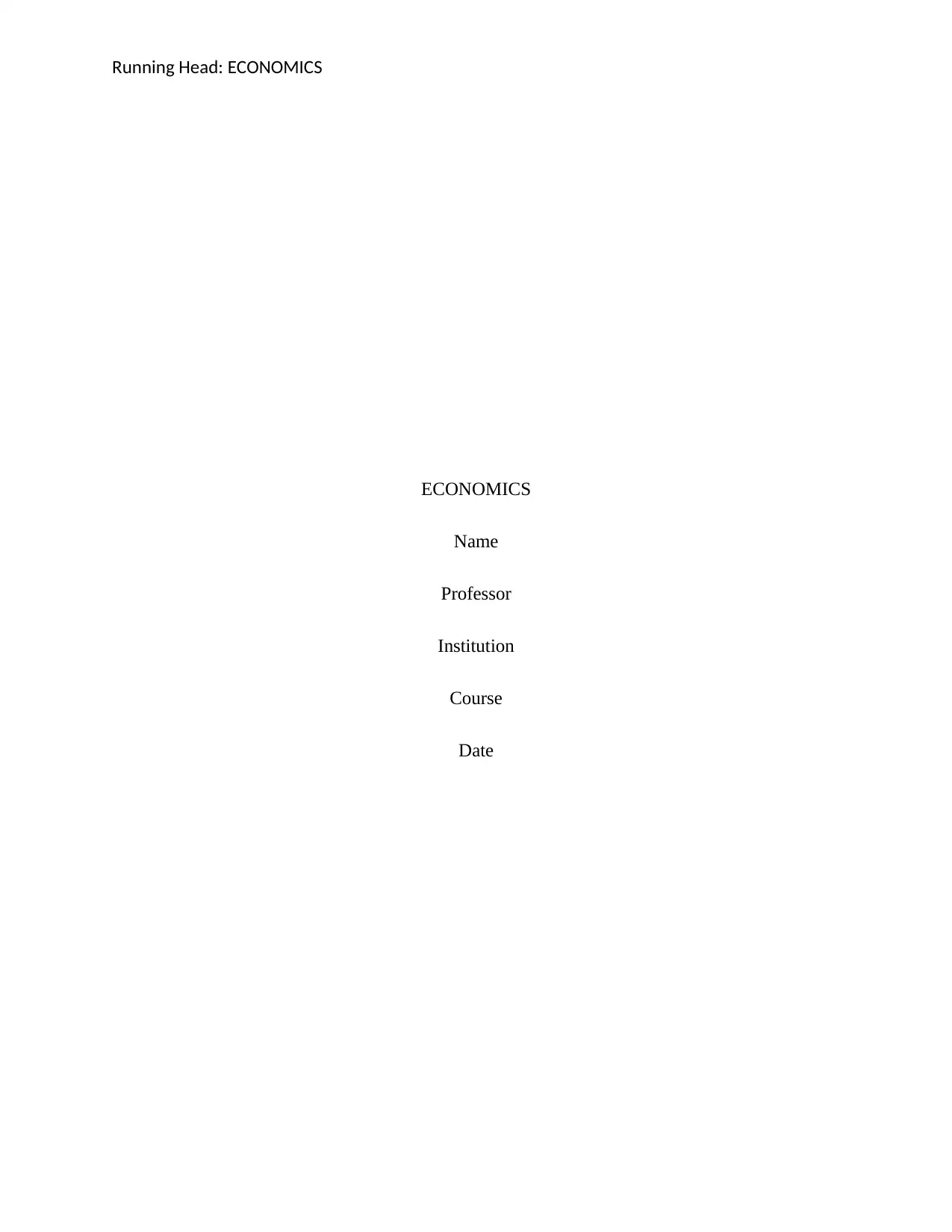
Running Head: ECONOMICS
ECONOMICS
Name
Professor
Institution
Course
Date
ECONOMICS
Name
Professor
Institution
Course
Date
Paraphrase This Document
Need a fresh take? Get an instant paraphrase of this document with our AI Paraphraser
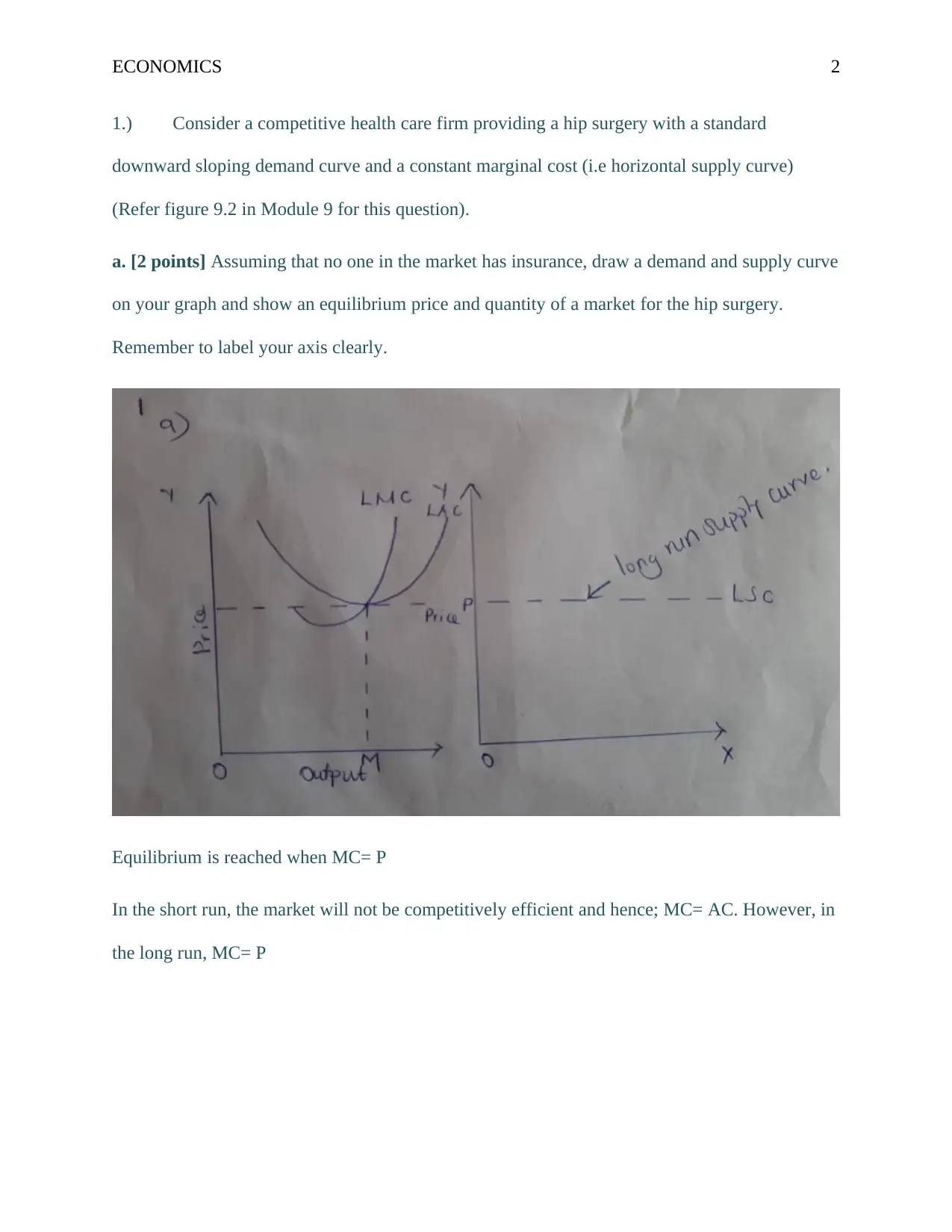
ECONOMICS 2
1.) Consider a competitive health care firm providing a hip surgery with a standard
downward sloping demand curve and a constant marginal cost (i.e horizontal supply curve)
(Refer figure 9.2 in Module 9 for this question).
a. [2 points] Assuming that no one in the market has insurance, draw a demand and supply curve
on your graph and show an equilibrium price and quantity of a market for the hip surgery.
Remember to label your axis clearly.
Equilibrium is reached when MC= P
In the short run, the market will not be competitively efficient and hence; MC= AC. However, in
the long run, MC= P
1.) Consider a competitive health care firm providing a hip surgery with a standard
downward sloping demand curve and a constant marginal cost (i.e horizontal supply curve)
(Refer figure 9.2 in Module 9 for this question).
a. [2 points] Assuming that no one in the market has insurance, draw a demand and supply curve
on your graph and show an equilibrium price and quantity of a market for the hip surgery.
Remember to label your axis clearly.
Equilibrium is reached when MC= P
In the short run, the market will not be competitively efficient and hence; MC= AC. However, in
the long run, MC= P
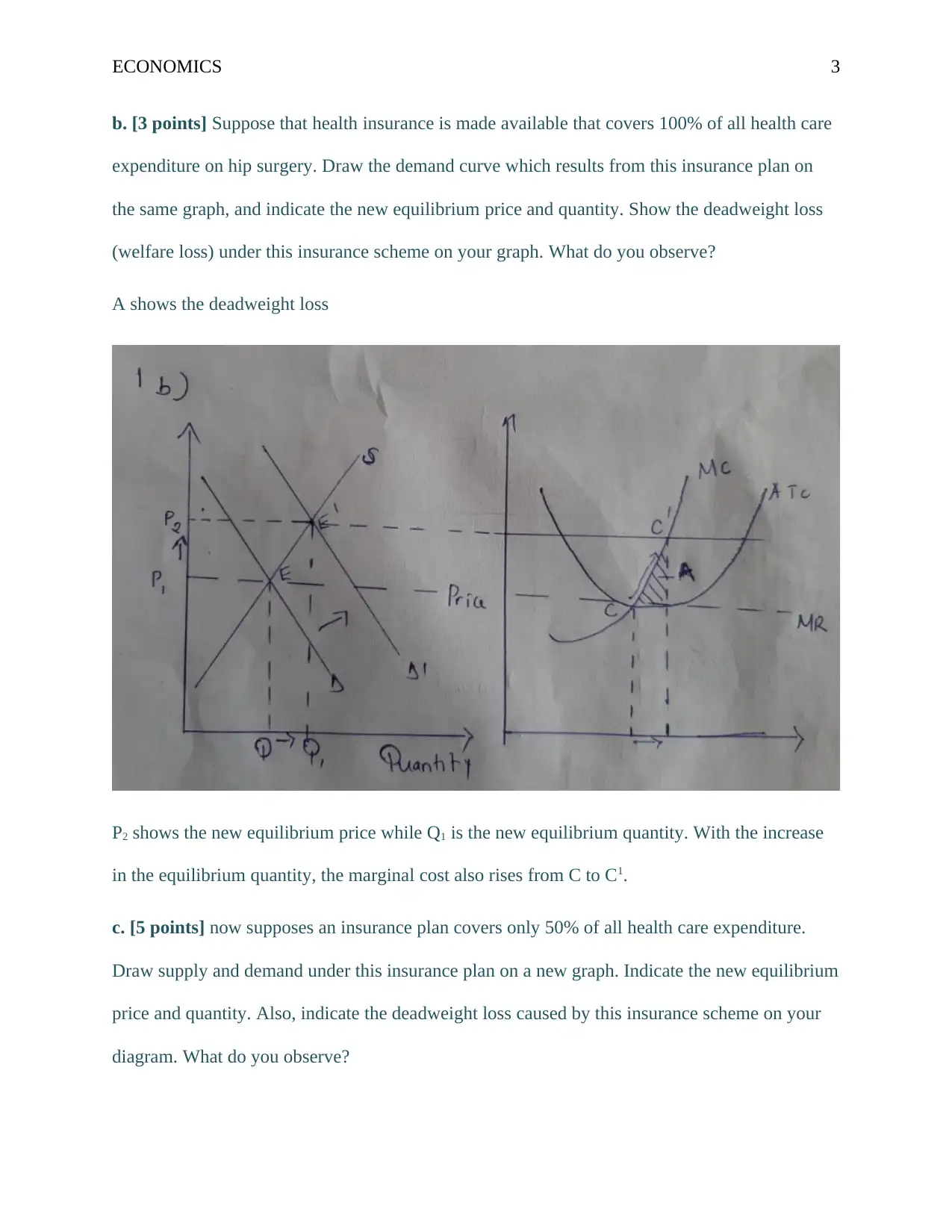
ECONOMICS 3
b. [3 points] Suppose that health insurance is made available that covers 100% of all health care
expenditure on hip surgery. Draw the demand curve which results from this insurance plan on
the same graph, and indicate the new equilibrium price and quantity. Show the deadweight loss
(welfare loss) under this insurance scheme on your graph. What do you observe?
A shows the deadweight loss
P2 shows the new equilibrium price while Q1 is the new equilibrium quantity. With the increase
in the equilibrium quantity, the marginal cost also rises from C to C1.
c. [5 points] now supposes an insurance plan covers only 50% of all health care expenditure.
Draw supply and demand under this insurance plan on a new graph. Indicate the new equilibrium
price and quantity. Also, indicate the deadweight loss caused by this insurance scheme on your
diagram. What do you observe?
b. [3 points] Suppose that health insurance is made available that covers 100% of all health care
expenditure on hip surgery. Draw the demand curve which results from this insurance plan on
the same graph, and indicate the new equilibrium price and quantity. Show the deadweight loss
(welfare loss) under this insurance scheme on your graph. What do you observe?
A shows the deadweight loss
P2 shows the new equilibrium price while Q1 is the new equilibrium quantity. With the increase
in the equilibrium quantity, the marginal cost also rises from C to C1.
c. [5 points] now supposes an insurance plan covers only 50% of all health care expenditure.
Draw supply and demand under this insurance plan on a new graph. Indicate the new equilibrium
price and quantity. Also, indicate the deadweight loss caused by this insurance scheme on your
diagram. What do you observe?
⊘ This is a preview!⊘
Do you want full access?
Subscribe today to unlock all pages.

Trusted by 1+ million students worldwide
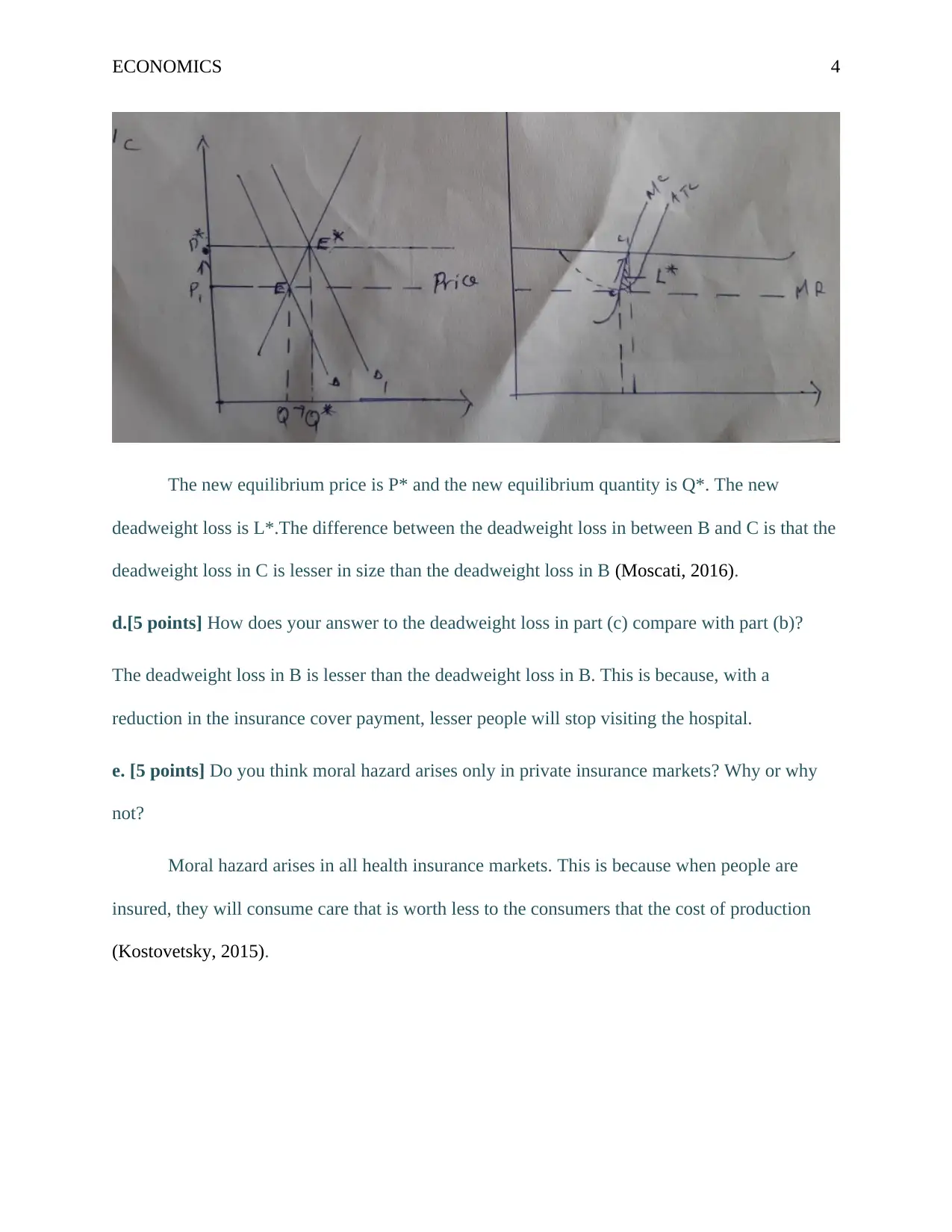
ECONOMICS 4
The new equilibrium price is P* and the new equilibrium quantity is Q*. The new
deadweight loss is L*.The difference between the deadweight loss in between B and C is that the
deadweight loss in C is lesser in size than the deadweight loss in B (Moscati, 2016).
d.[5 points] How does your answer to the deadweight loss in part (c) compare with part (b)?
The deadweight loss in B is lesser than the deadweight loss in B. This is because, with a
reduction in the insurance cover payment, lesser people will stop visiting the hospital.
e. [5 points] Do you think moral hazard arises only in private insurance markets? Why or why
not?
Moral hazard arises in all health insurance markets. This is because when people are
insured, they will consume care that is worth less to the consumers that the cost of production
(Kostovetsky, 2015).
The new equilibrium price is P* and the new equilibrium quantity is Q*. The new
deadweight loss is L*.The difference between the deadweight loss in between B and C is that the
deadweight loss in C is lesser in size than the deadweight loss in B (Moscati, 2016).
d.[5 points] How does your answer to the deadweight loss in part (c) compare with part (b)?
The deadweight loss in B is lesser than the deadweight loss in B. This is because, with a
reduction in the insurance cover payment, lesser people will stop visiting the hospital.
e. [5 points] Do you think moral hazard arises only in private insurance markets? Why or why
not?
Moral hazard arises in all health insurance markets. This is because when people are
insured, they will consume care that is worth less to the consumers that the cost of production
(Kostovetsky, 2015).
Paraphrase This Document
Need a fresh take? Get an instant paraphrase of this document with our AI Paraphraser
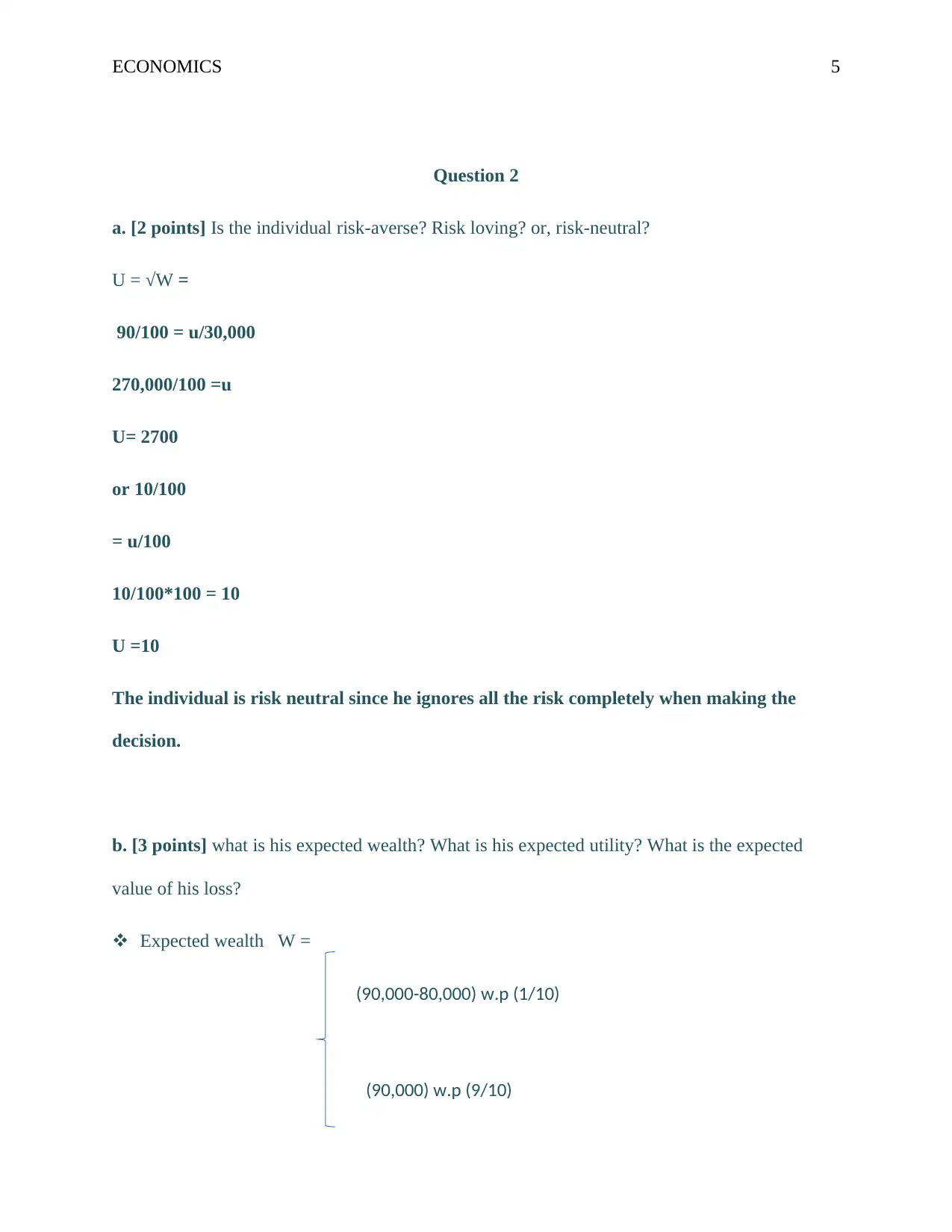
ECONOMICS 5
Question 2
a. [2 points] Is the individual risk-averse? Risk loving? or, risk-neutral?
U = √W =
90/100 = u/30,000
270,000/100 =u
U= 2700
or 10/100
= u/100
10/100*100 = 10
U =10
The individual is risk neutral since he ignores all the risk completely when making the
decision.
b. [3 points] what is his expected wealth? What is his expected utility? What is the expected
value of his loss?
Expected wealth W =
(90,000-80,000) w.p (1/10)
(90,000) w.p (9/10)
Question 2
a. [2 points] Is the individual risk-averse? Risk loving? or, risk-neutral?
U = √W =
90/100 = u/30,000
270,000/100 =u
U= 2700
or 10/100
= u/100
10/100*100 = 10
U =10
The individual is risk neutral since he ignores all the risk completely when making the
decision.
b. [3 points] what is his expected wealth? What is his expected utility? What is the expected
value of his loss?
Expected wealth W =
(90,000-80,000) w.p (1/10)
(90,000) w.p (9/10)
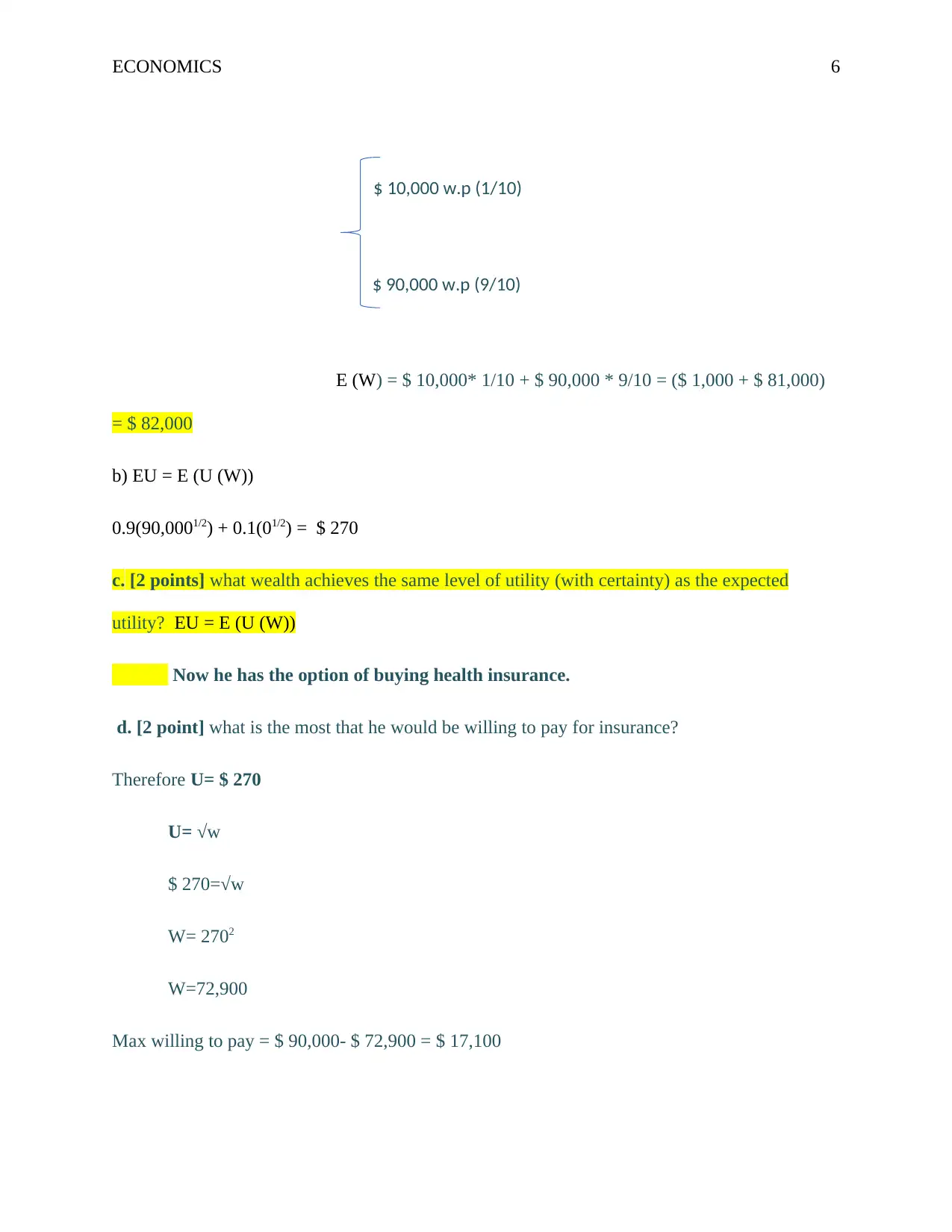
ECONOMICS 6
$ 10,000 w.p (1/10)
$ 90,000 w.p (9/10)
E (W) = $ 10,000* 1/10 + $ 90,000 * 9/10 = ($ 1,000 + $ 81,000)
= $ 82,000
b) EU = E (U (W))
0.9(90,0001/2) + 0.1(01/2) = $ 270
c. [2 points] what wealth achieves the same level of utility (with certainty) as the expected
utility? EU = E (U (W))
Now he has the option of buying health insurance.
d. [2 point] what is the most that he would be willing to pay for insurance?
Therefore U= $ 270
U= √w
$ 270=√w
W= 2702
W=72,900
Max willing to pay = $ 90,000- $ 72,900 = $ 17,100
$ 10,000 w.p (1/10)
$ 90,000 w.p (9/10)
E (W) = $ 10,000* 1/10 + $ 90,000 * 9/10 = ($ 1,000 + $ 81,000)
= $ 82,000
b) EU = E (U (W))
0.9(90,0001/2) + 0.1(01/2) = $ 270
c. [2 points] what wealth achieves the same level of utility (with certainty) as the expected
utility? EU = E (U (W))
Now he has the option of buying health insurance.
d. [2 point] what is the most that he would be willing to pay for insurance?
Therefore U= $ 270
U= √w
$ 270=√w
W= 2702
W=72,900
Max willing to pay = $ 90,000- $ 72,900 = $ 17,100
⊘ This is a preview!⊘
Do you want full access?
Subscribe today to unlock all pages.

Trusted by 1+ million students worldwide
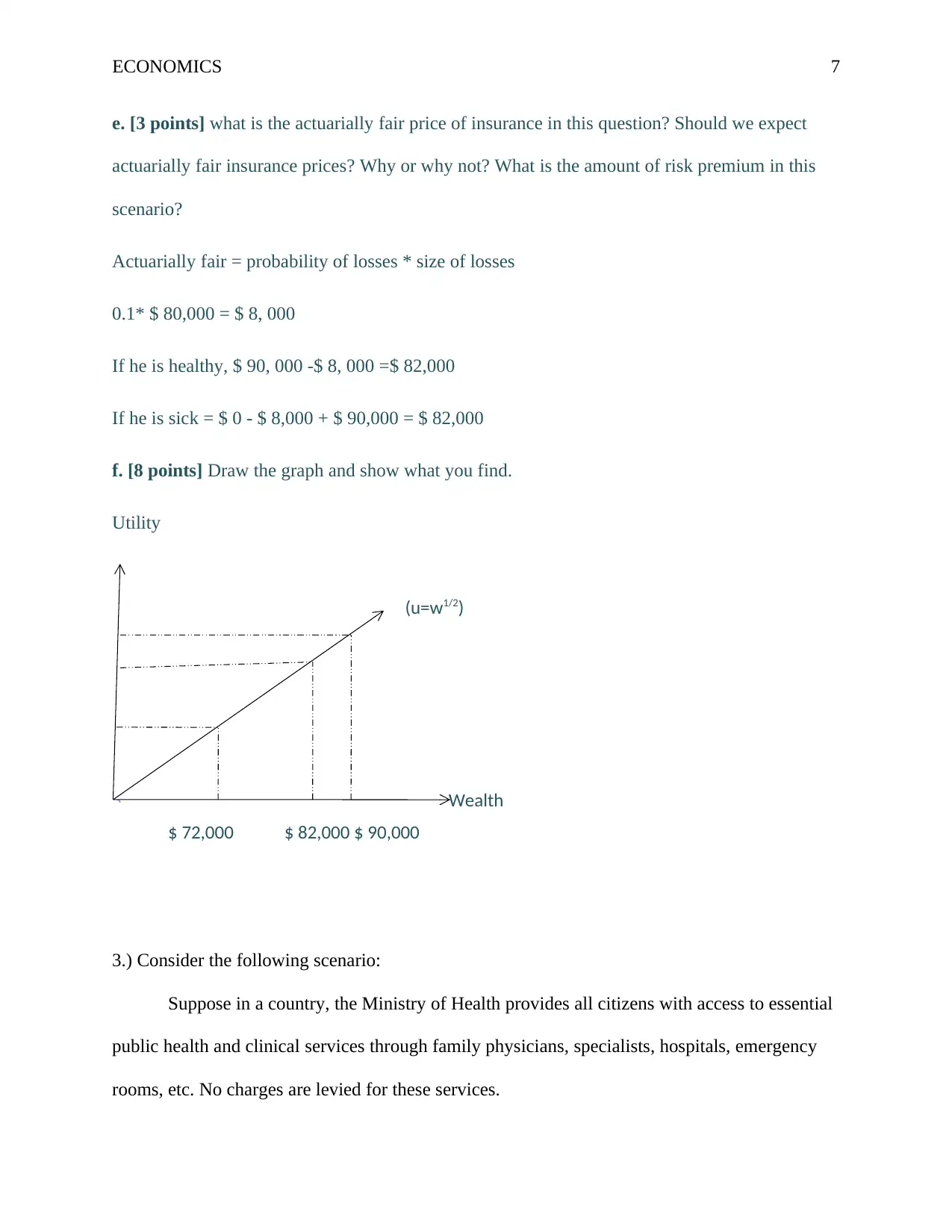
ECONOMICS 7
e. [3 points] what is the actuarially fair price of insurance in this question? Should we expect
actuarially fair insurance prices? Why or why not? What is the amount of risk premium in this
scenario?
Actuarially fair = probability of losses * size of losses
0.1* $ 80,000 = $ 8, 000
If he is healthy, $ 90, 000 -$ 8, 000 =$ 82,000
If he is sick = $ 0 - $ 8,000 + $ 90,000 = $ 82,000
f. [8 points] Draw the graph and show what you find.
Utility
(u=w1/2)
Wealth
$ 72,000 $ 82,000 $ 90,000
3.) Consider the following scenario:
Suppose in a country, the Ministry of Health provides all citizens with access to essential
public health and clinical services through family physicians, specialists, hospitals, emergency
rooms, etc. No charges are levied for these services.
e. [3 points] what is the actuarially fair price of insurance in this question? Should we expect
actuarially fair insurance prices? Why or why not? What is the amount of risk premium in this
scenario?
Actuarially fair = probability of losses * size of losses
0.1* $ 80,000 = $ 8, 000
If he is healthy, $ 90, 000 -$ 8, 000 =$ 82,000
If he is sick = $ 0 - $ 8,000 + $ 90,000 = $ 82,000
f. [8 points] Draw the graph and show what you find.
Utility
(u=w1/2)
Wealth
$ 72,000 $ 82,000 $ 90,000
3.) Consider the following scenario:
Suppose in a country, the Ministry of Health provides all citizens with access to essential
public health and clinical services through family physicians, specialists, hospitals, emergency
rooms, etc. No charges are levied for these services.
Paraphrase This Document
Need a fresh take? Get an instant paraphrase of this document with our AI Paraphraser
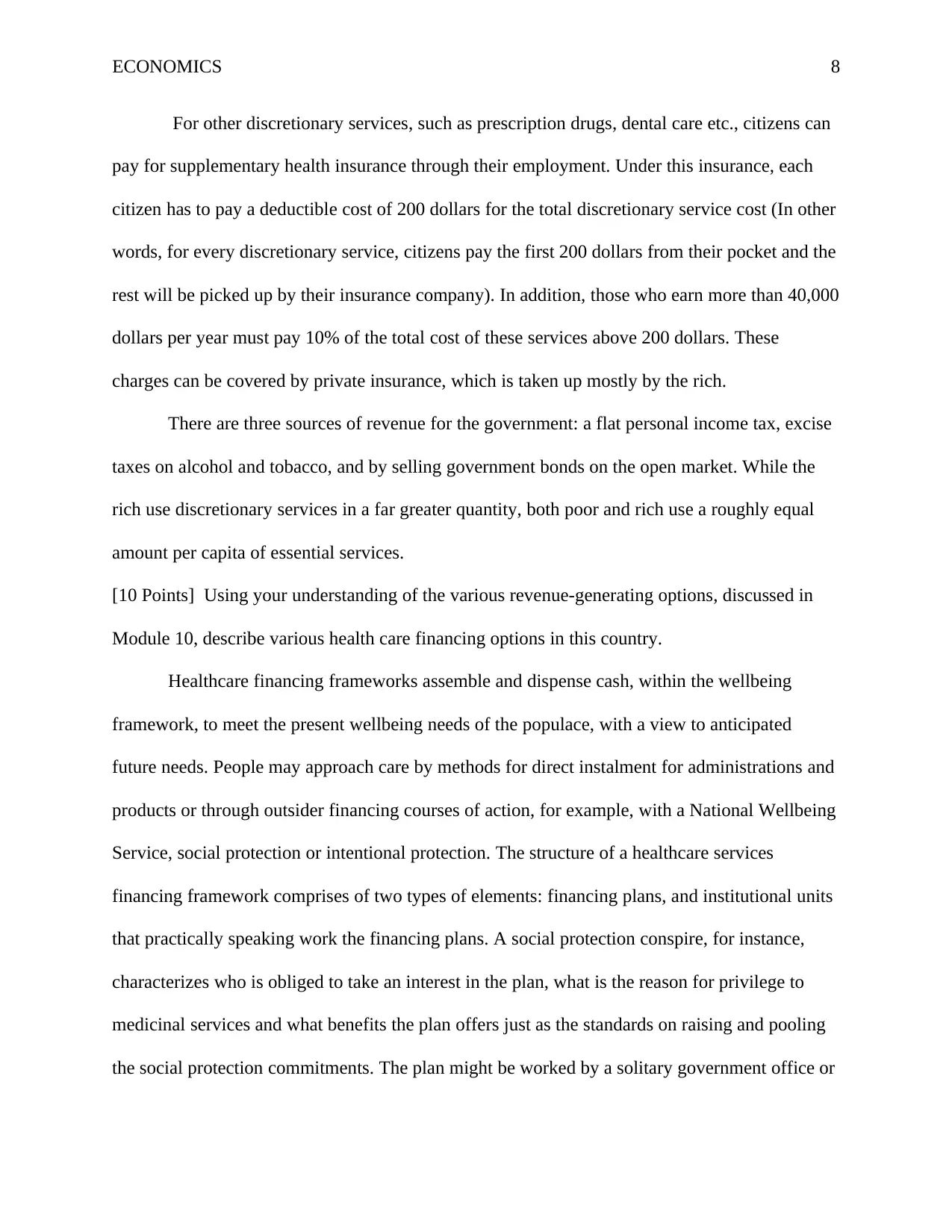
ECONOMICS 8
For other discretionary services, such as prescription drugs, dental care etc., citizens can
pay for supplementary health insurance through their employment. Under this insurance, each
citizen has to pay a deductible cost of 200 dollars for the total discretionary service cost (In other
words, for every discretionary service, citizens pay the first 200 dollars from their pocket and the
rest will be picked up by their insurance company). In addition, those who earn more than 40,000
dollars per year must pay 10% of the total cost of these services above 200 dollars. These
charges can be covered by private insurance, which is taken up mostly by the rich.
There are three sources of revenue for the government: a flat personal income tax, excise
taxes on alcohol and tobacco, and by selling government bonds on the open market. While the
rich use discretionary services in a far greater quantity, both poor and rich use a roughly equal
amount per capita of essential services.
[10 Points] Using your understanding of the various revenue-generating options, discussed in
Module 10, describe various health care financing options in this country.
Healthcare financing frameworks assemble and dispense cash, within the wellbeing
framework, to meet the present wellbeing needs of the populace, with a view to anticipated
future needs. People may approach care by methods for direct instalment for administrations and
products or through outsider financing courses of action, for example, with a National Wellbeing
Service, social protection or intentional protection. The structure of a healthcare services
financing framework comprises of two types of elements: financing plans, and institutional units
that practically speaking work the financing plans. A social protection conspire, for instance,
characterizes who is obliged to take an interest in the plan, what is the reason for privilege to
medicinal services and what benefits the plan offers just as the standards on raising and pooling
the social protection commitments. The plan might be worked by a solitary government office or
For other discretionary services, such as prescription drugs, dental care etc., citizens can
pay for supplementary health insurance through their employment. Under this insurance, each
citizen has to pay a deductible cost of 200 dollars for the total discretionary service cost (In other
words, for every discretionary service, citizens pay the first 200 dollars from their pocket and the
rest will be picked up by their insurance company). In addition, those who earn more than 40,000
dollars per year must pay 10% of the total cost of these services above 200 dollars. These
charges can be covered by private insurance, which is taken up mostly by the rich.
There are three sources of revenue for the government: a flat personal income tax, excise
taxes on alcohol and tobacco, and by selling government bonds on the open market. While the
rich use discretionary services in a far greater quantity, both poor and rich use a roughly equal
amount per capita of essential services.
[10 Points] Using your understanding of the various revenue-generating options, discussed in
Module 10, describe various health care financing options in this country.
Healthcare financing frameworks assemble and dispense cash, within the wellbeing
framework, to meet the present wellbeing needs of the populace, with a view to anticipated
future needs. People may approach care by methods for direct instalment for administrations and
products or through outsider financing courses of action, for example, with a National Wellbeing
Service, social protection or intentional protection. The structure of a healthcare services
financing framework comprises of two types of elements: financing plans, and institutional units
that practically speaking work the financing plans. A social protection conspire, for instance,
characterizes who is obliged to take an interest in the plan, what is the reason for privilege to
medicinal services and what benefits the plan offers just as the standards on raising and pooling
the social protection commitments. The plan might be worked by a solitary government office or
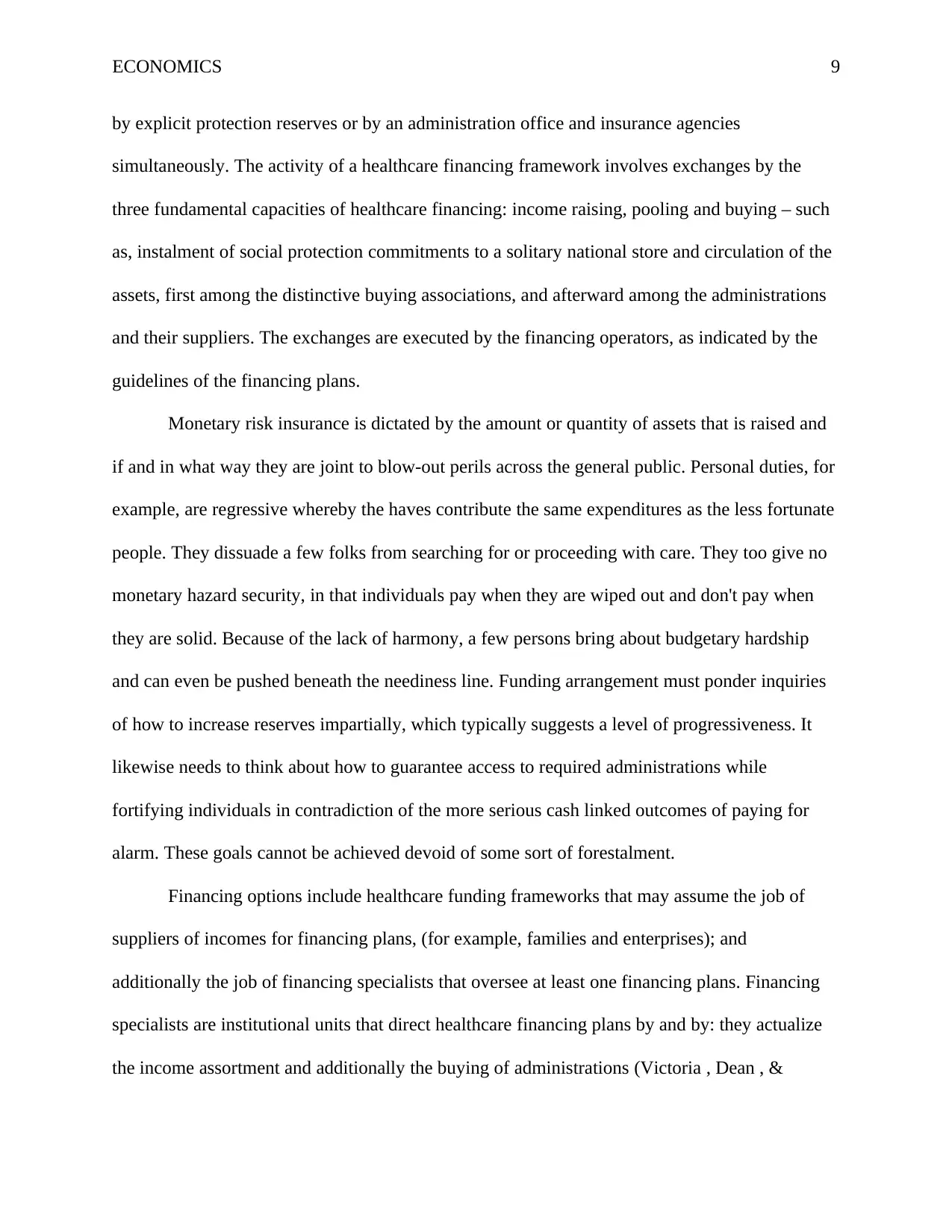
ECONOMICS 9
by explicit protection reserves or by an administration office and insurance agencies
simultaneously. The activity of a healthcare financing framework involves exchanges by the
three fundamental capacities of healthcare financing: income raising, pooling and buying – such
as, instalment of social protection commitments to a solitary national store and circulation of the
assets, first among the distinctive buying associations, and afterward among the administrations
and their suppliers. The exchanges are executed by the financing operators, as indicated by the
guidelines of the financing plans.
Monetary risk insurance is dictated by the amount or quantity of assets that is raised and
if and in what way they are joint to blow-out perils across the general public. Personal duties, for
example, are regressive whereby the haves contribute the same expenditures as the less fortunate
people. They dissuade a few folks from searching for or proceeding with care. They too give no
monetary hazard security, in that individuals pay when they are wiped out and don't pay when
they are solid. Because of the lack of harmony, a few persons bring about budgetary hardship
and can even be pushed beneath the neediness line. Funding arrangement must ponder inquiries
of how to increase reserves impartially, which typically suggests a level of progressiveness. It
likewise needs to think about how to guarantee access to required administrations while
fortifying individuals in contradiction of the more serious cash linked outcomes of paying for
alarm. These goals cannot be achieved devoid of some sort of forestalment.
Financing options include healthcare funding frameworks that may assume the job of
suppliers of incomes for financing plans, (for example, families and enterprises); and
additionally the job of financing specialists that oversee at least one financing plans. Financing
specialists are institutional units that direct healthcare financing plans by and by: they actualize
the income assortment and additionally the buying of administrations (Victoria , Dean , &
by explicit protection reserves or by an administration office and insurance agencies
simultaneously. The activity of a healthcare financing framework involves exchanges by the
three fundamental capacities of healthcare financing: income raising, pooling and buying – such
as, instalment of social protection commitments to a solitary national store and circulation of the
assets, first among the distinctive buying associations, and afterward among the administrations
and their suppliers. The exchanges are executed by the financing operators, as indicated by the
guidelines of the financing plans.
Monetary risk insurance is dictated by the amount or quantity of assets that is raised and
if and in what way they are joint to blow-out perils across the general public. Personal duties, for
example, are regressive whereby the haves contribute the same expenditures as the less fortunate
people. They dissuade a few folks from searching for or proceeding with care. They too give no
monetary hazard security, in that individuals pay when they are wiped out and don't pay when
they are solid. Because of the lack of harmony, a few persons bring about budgetary hardship
and can even be pushed beneath the neediness line. Funding arrangement must ponder inquiries
of how to increase reserves impartially, which typically suggests a level of progressiveness. It
likewise needs to think about how to guarantee access to required administrations while
fortifying individuals in contradiction of the more serious cash linked outcomes of paying for
alarm. These goals cannot be achieved devoid of some sort of forestalment.
Financing options include healthcare funding frameworks that may assume the job of
suppliers of incomes for financing plans, (for example, families and enterprises); and
additionally the job of financing specialists that oversee at least one financing plans. Financing
specialists are institutional units that direct healthcare financing plans by and by: they actualize
the income assortment and additionally the buying of administrations (Victoria , Dean , &
⊘ This is a preview!⊘
Do you want full access?
Subscribe today to unlock all pages.

Trusted by 1+ million students worldwide
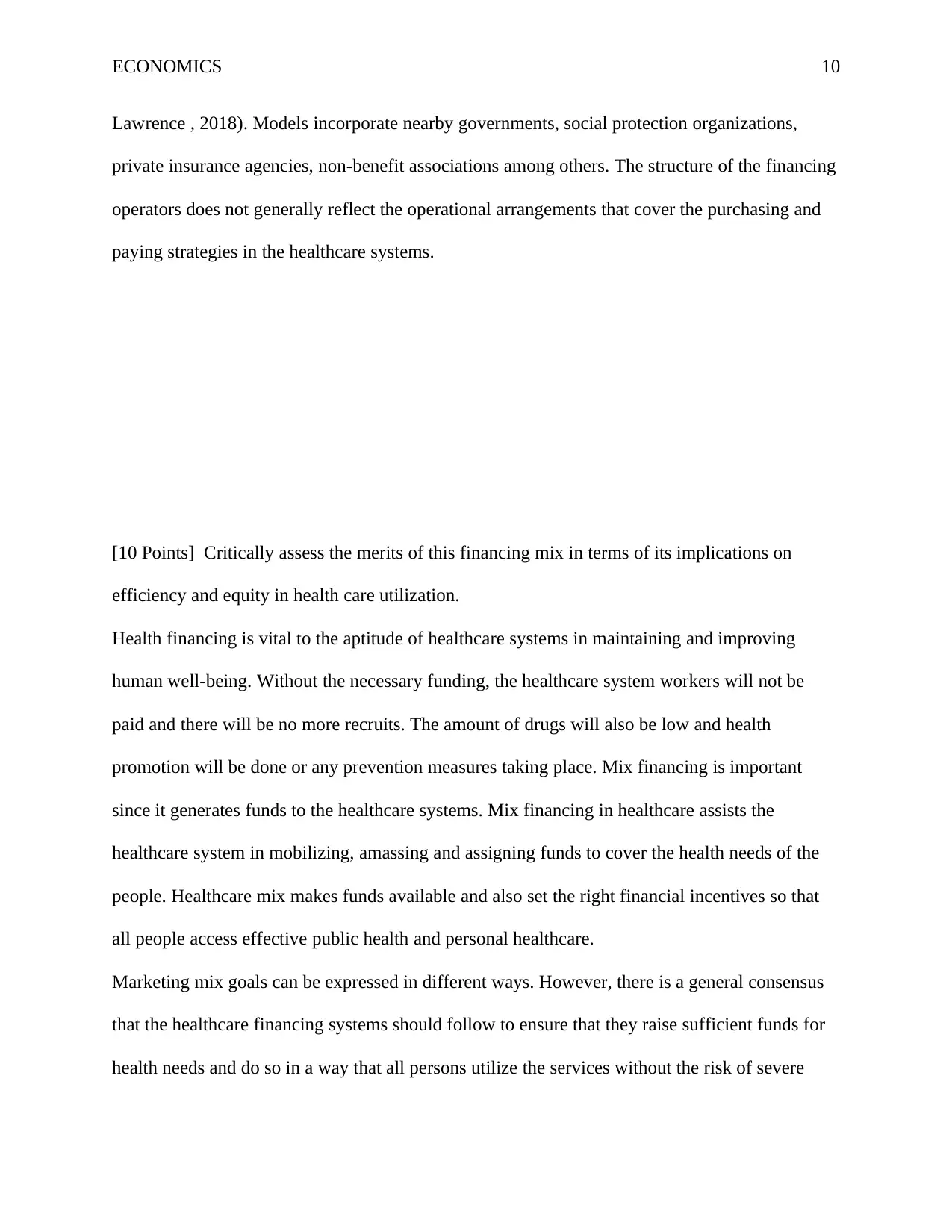
ECONOMICS 10
Lawrence , 2018). Models incorporate nearby governments, social protection organizations,
private insurance agencies, non-benefit associations among others. The structure of the financing
operators does not generally reflect the operational arrangements that cover the purchasing and
paying strategies in the healthcare systems.
[10 Points] Critically assess the merits of this financing mix in terms of its implications on
efficiency and equity in health care utilization.
Health financing is vital to the aptitude of healthcare systems in maintaining and improving
human well-being. Without the necessary funding, the healthcare system workers will not be
paid and there will be no more recruits. The amount of drugs will also be low and health
promotion will be done or any prevention measures taking place. Mix financing is important
since it generates funds to the healthcare systems. Mix financing in healthcare assists the
healthcare system in mobilizing, amassing and assigning funds to cover the health needs of the
people. Healthcare mix makes funds available and also set the right financial incentives so that
all people access effective public health and personal healthcare.
Marketing mix goals can be expressed in different ways. However, there is a general consensus
that the healthcare financing systems should follow to ensure that they raise sufficient funds for
health needs and do so in a way that all persons utilize the services without the risk of severe
Lawrence , 2018). Models incorporate nearby governments, social protection organizations,
private insurance agencies, non-benefit associations among others. The structure of the financing
operators does not generally reflect the operational arrangements that cover the purchasing and
paying strategies in the healthcare systems.
[10 Points] Critically assess the merits of this financing mix in terms of its implications on
efficiency and equity in health care utilization.
Health financing is vital to the aptitude of healthcare systems in maintaining and improving
human well-being. Without the necessary funding, the healthcare system workers will not be
paid and there will be no more recruits. The amount of drugs will also be low and health
promotion will be done or any prevention measures taking place. Mix financing is important
since it generates funds to the healthcare systems. Mix financing in healthcare assists the
healthcare system in mobilizing, amassing and assigning funds to cover the health needs of the
people. Healthcare mix makes funds available and also set the right financial incentives so that
all people access effective public health and personal healthcare.
Marketing mix goals can be expressed in different ways. However, there is a general consensus
that the healthcare financing systems should follow to ensure that they raise sufficient funds for
health needs and do so in a way that all persons utilize the services without the risk of severe
Paraphrase This Document
Need a fresh take? Get an instant paraphrase of this document with our AI Paraphraser
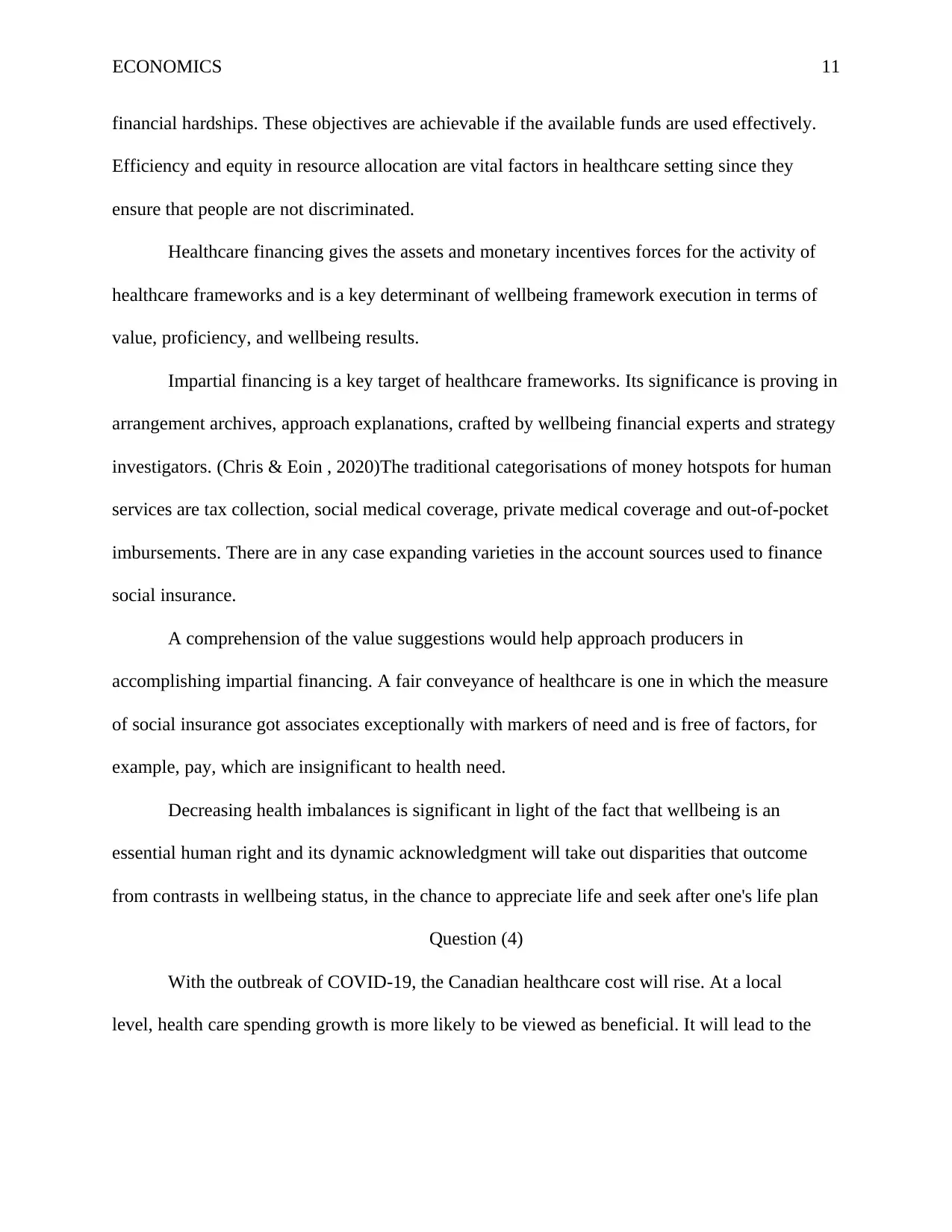
ECONOMICS 11
financial hardships. These objectives are achievable if the available funds are used effectively.
Efficiency and equity in resource allocation are vital factors in healthcare setting since they
ensure that people are not discriminated.
Healthcare financing gives the assets and monetary incentives forces for the activity of
healthcare frameworks and is a key determinant of wellbeing framework execution in terms of
value, proficiency, and wellbeing results.
Impartial financing is a key target of healthcare frameworks. Its significance is proving in
arrangement archives, approach explanations, crafted by wellbeing financial experts and strategy
investigators. (Chris & Eoin , 2020)The traditional categorisations of money hotspots for human
services are tax collection, social medical coverage, private medical coverage and out-of-pocket
imbursements. There are in any case expanding varieties in the account sources used to finance
social insurance.
A comprehension of the value suggestions would help approach producers in
accomplishing impartial financing. A fair conveyance of healthcare is one in which the measure
of social insurance got associates exceptionally with markers of need and is free of factors, for
example, pay, which are insignificant to health need.
Decreasing health imbalances is significant in light of the fact that wellbeing is an
essential human right and its dynamic acknowledgment will take out disparities that outcome
from contrasts in wellbeing status, in the chance to appreciate life and seek after one's life plan
Question (4)
With the outbreak of COVID-19, the Canadian healthcare cost will rise. At a local
level, health care spending growth is more likely to be viewed as beneficial. It will lead to the
financial hardships. These objectives are achievable if the available funds are used effectively.
Efficiency and equity in resource allocation are vital factors in healthcare setting since they
ensure that people are not discriminated.
Healthcare financing gives the assets and monetary incentives forces for the activity of
healthcare frameworks and is a key determinant of wellbeing framework execution in terms of
value, proficiency, and wellbeing results.
Impartial financing is a key target of healthcare frameworks. Its significance is proving in
arrangement archives, approach explanations, crafted by wellbeing financial experts and strategy
investigators. (Chris & Eoin , 2020)The traditional categorisations of money hotspots for human
services are tax collection, social medical coverage, private medical coverage and out-of-pocket
imbursements. There are in any case expanding varieties in the account sources used to finance
social insurance.
A comprehension of the value suggestions would help approach producers in
accomplishing impartial financing. A fair conveyance of healthcare is one in which the measure
of social insurance got associates exceptionally with markers of need and is free of factors, for
example, pay, which are insignificant to health need.
Decreasing health imbalances is significant in light of the fact that wellbeing is an
essential human right and its dynamic acknowledgment will take out disparities that outcome
from contrasts in wellbeing status, in the chance to appreciate life and seek after one's life plan
Question (4)
With the outbreak of COVID-19, the Canadian healthcare cost will rise. At a local
level, health care spending growth is more likely to be viewed as beneficial. It will lead to the
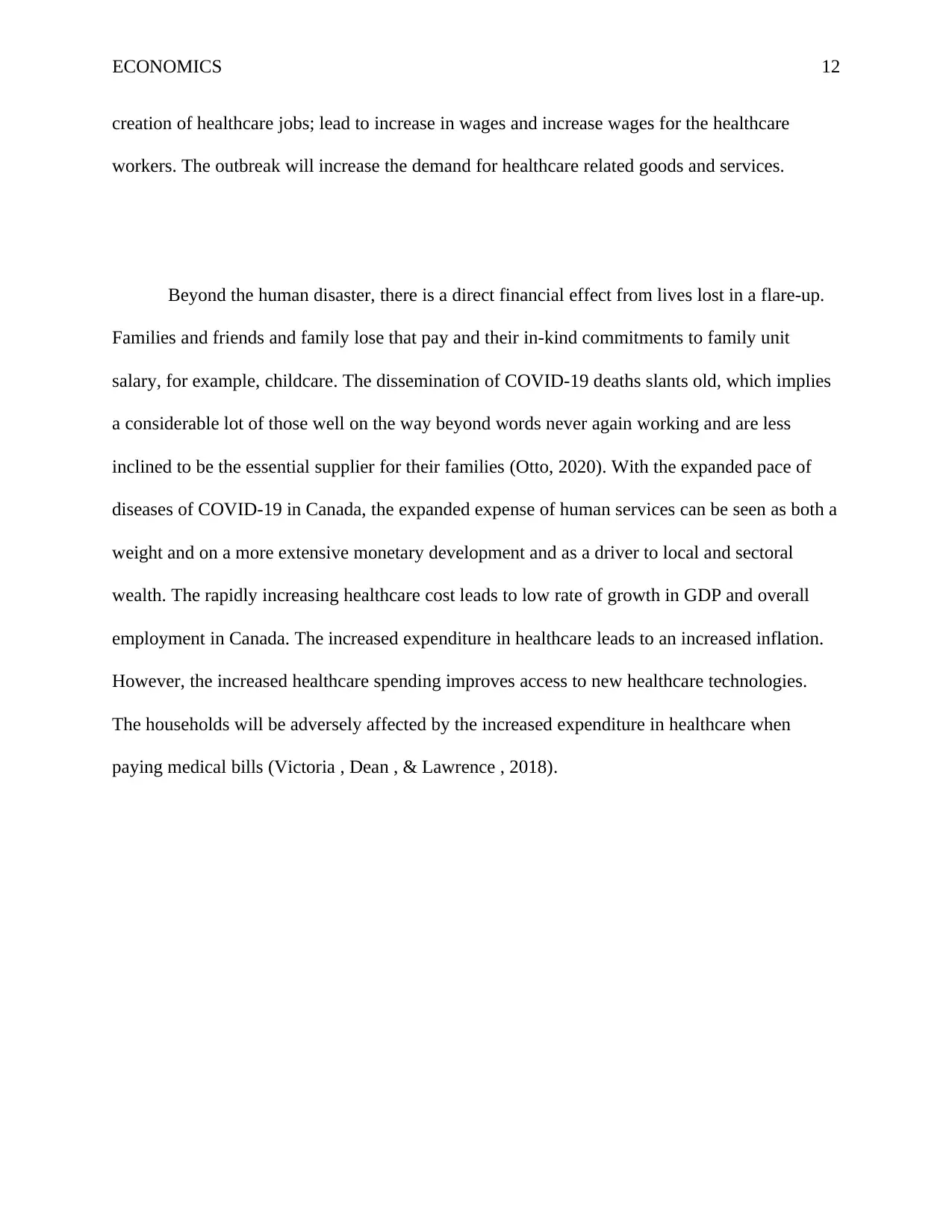
ECONOMICS 12
creation of healthcare jobs; lead to increase in wages and increase wages for the healthcare
workers. The outbreak will increase the demand for healthcare related goods and services.
Beyond the human disaster, there is a direct financial effect from lives lost in a flare-up.
Families and friends and family lose that pay and their in-kind commitments to family unit
salary, for example, childcare. The dissemination of COVID-19 deaths slants old, which implies
a considerable lot of those well on the way beyond words never again working and are less
inclined to be the essential supplier for their families (Otto, 2020). With the expanded pace of
diseases of COVID-19 in Canada, the expanded expense of human services can be seen as both a
weight and on a more extensive monetary development and as a driver to local and sectoral
wealth. The rapidly increasing healthcare cost leads to low rate of growth in GDP and overall
employment in Canada. The increased expenditure in healthcare leads to an increased inflation.
However, the increased healthcare spending improves access to new healthcare technologies.
The households will be adversely affected by the increased expenditure in healthcare when
paying medical bills (Victoria , Dean , & Lawrence , 2018).
creation of healthcare jobs; lead to increase in wages and increase wages for the healthcare
workers. The outbreak will increase the demand for healthcare related goods and services.
Beyond the human disaster, there is a direct financial effect from lives lost in a flare-up.
Families and friends and family lose that pay and their in-kind commitments to family unit
salary, for example, childcare. The dissemination of COVID-19 deaths slants old, which implies
a considerable lot of those well on the way beyond words never again working and are less
inclined to be the essential supplier for their families (Otto, 2020). With the expanded pace of
diseases of COVID-19 in Canada, the expanded expense of human services can be seen as both a
weight and on a more extensive monetary development and as a driver to local and sectoral
wealth. The rapidly increasing healthcare cost leads to low rate of growth in GDP and overall
employment in Canada. The increased expenditure in healthcare leads to an increased inflation.
However, the increased healthcare spending improves access to new healthcare technologies.
The households will be adversely affected by the increased expenditure in healthcare when
paying medical bills (Victoria , Dean , & Lawrence , 2018).
⊘ This is a preview!⊘
Do you want full access?
Subscribe today to unlock all pages.

Trusted by 1+ million students worldwide
1 out of 14
Related Documents
Your All-in-One AI-Powered Toolkit for Academic Success.
+13062052269
info@desklib.com
Available 24*7 on WhatsApp / Email
![[object Object]](/_next/static/media/star-bottom.7253800d.svg)
Unlock your academic potential
Copyright © 2020–2025 A2Z Services. All Rights Reserved. Developed and managed by ZUCOL.





